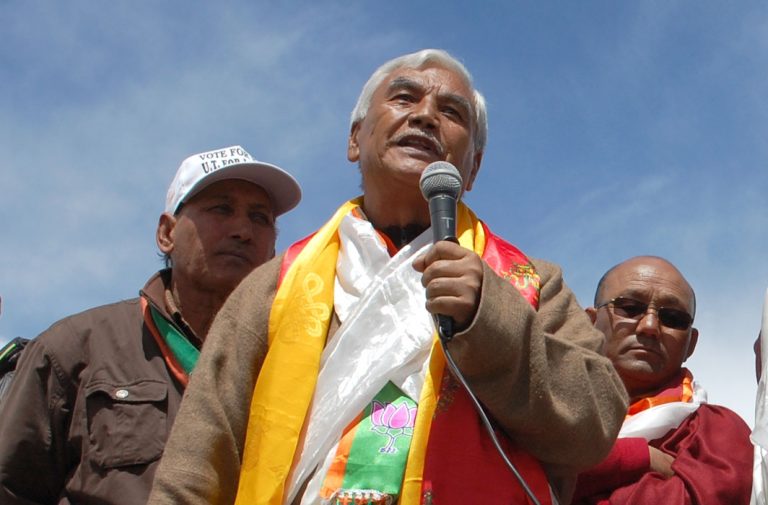
By Pushp Saraf
Can Thupstan Chhewang, twice member of the Lok Sabha from the trans-Himalayan territory of Ladakh in Jammu and Kashmir, become a rallying point for strengthening of the fabled Buddhist unity of the idyllic Leh district after his resignation from the Bharatiya Janata Party and Parliament?
His resignation on November 14 followed by a strongly-worded letter to Prime Minister Narendra Modi on November 19 exposing the glaring difference between the party’s promises and actual performance has drawn overwhelming positive response from his electorate on the social media. He has specifically referred to the central leadership’s inability to take any concrete step towards granting union territory status to Ladakh and the inclusion of the Bhoti language in the Eighth Schedule of the Indian Constitutions. Both the issues are extremely sentimental for the region which has been agitating for UT status in particular ever since J&K’s accession with India in 1947.
During the 2014 election campaign the BJP had promised UT “within six months” of coming to power. Despite clash of political ambitions at times the leaders of Ladakh have so far managed to keep their unity intact on the demand for UT.
A group of five leaders led by Tsering Samphel, president of the Ladakh Buddhist Association (LBA), gave a powerful push to the predominantly Buddhist agitation for UT status in the late 1980s. Thupstan Chhewang was a pillar of the movement along with Tsering Dorjay, Rigzin Jora and Rigzin Sparlbar, all of them young at that point. There was violence on a couple of occasions. They swam and suffered together. Their unity became stronger as the militancy in the Valley took a serious turn.
Ladakh is a distinct geographical identity with two districts of mainly Buddhist Leh and the Shia-majority Kargil. Administratively it is part of the Kashmir Division as a result of which it is directly impacted by whatever happens in Srinagar.
Their stir achieved first breakthrough in 1995 when Leh was given a self-governing apparatus in the form of the Ladakh Autonomous Hill Development Council (LAHDC, Leh). Thupstan was elected the first head of the Council. Kargil was skeptical for a long time and was persuaded by then Chief Minister Mufti Mohammad Sayeed to adopt the Council in 2003 and, from all accounts, it has realised that it is never too late to follow a good model. Since then both the Councils, which are elected bodies, have been given more administrative, financial and legislative powers. However, their dream of UT remains distant and they have been chasing it especially in Leh. Kargil does not toe this line.
The Buddhist leaders of Leh, in a remarkable development, dissolved their local party units and formed a united front called the Ladakh Union Territory Front (LUTF) in 2002. It was as the LUTF nominee that Thupstan was elected as a member of the Lok Sabha for the first time. Gradually, however, the cracks appeared in the LUTF and widened with Rigzin Jora leading the revival of the Congress in Leh by pulling it out of the LUTF. Jora, who is presently leader of the Congress legislature party in the J&K Assembly, along with Samphel and Spalbar moved to the Congress which already had old loyalists like former Union minister P. Namgyal leaving the LUTF a wrecked ship. The Leh unit of the Congress rode high on the strength of the organisational support from New Delhi and the State significantly eclipsing the LUTF.
On the other hand, Thupstan and Dorjay felt terribly let down. They were not even informed about the Congress’s revival plan even though they had been party activists in the past. Moreover, the former was sitting MP and the latter the LUTF chief when their long-time colleagues left them in the dark about their parting plans.
The rift between the established leaders gave the BJP the breakthrough it needed to widen its base. The party wooed Thupstan and Dorjay. What followed is recent history. Thupstan avenged his earlier setback and won for the BJP the Parliamentary seat and the Hill Council for the first time. Dorjay became a member of the Legislative Council and a Cabinet minister with the BJP forming the Government in J&K under the leadership of the People’s Democratic Party (PDP).
Regardless of their serious political clash all Buddhist leaders of Leh stayed together on the issue of UT. In the latest round the differences in the BJP appear deep and irreconcilable especially after the manner in which Dorjay Motup has been dropped as Chairman and the Chief Executive Councillor of the Hill Council and replaced by young and ambitious Jamyang Tsering Namgal. The Congress is watching from the fence and deriving vicarious pleasure from the BJP’s discomfiture applauded Thupstan for taking a bold step. For the first time Thupstan and Dorjay are in the opposite camps with the latter staying put in the BJP.
It is unlikely, however, that any leader would stray from the demand for the UT. Whatever the stand of their national leaders, the local representatives of both the BJP and the Congress are united on this issue. In fact, all of them will stay together if nothing else under the popular pressure in Leh which is tilted towards having a direct administrative relationship with New Delhi instead of taking a circuitous route through Jammu or Srinagar as a constituent of J&K.
In this emerging milieu Thupstan may again find the leadership thrust upon him by the people at large. By resigning from the party and more significantly from Parliament on a major issue he has created a stir and moved the majority on the home turf. His moves in the days to come will be watched with interest.

